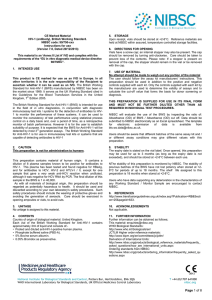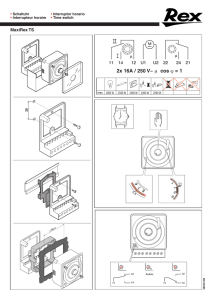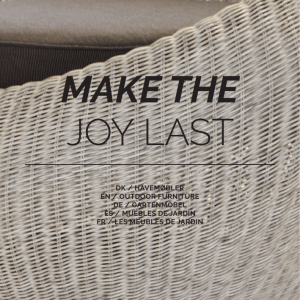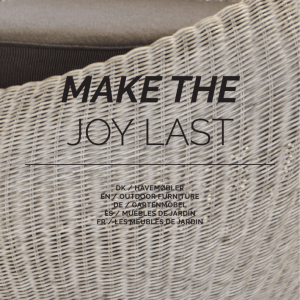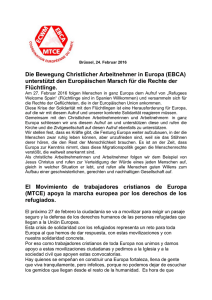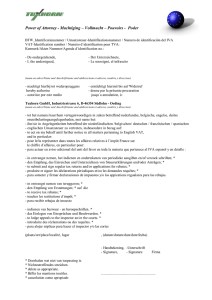HIV-2 (antibody) Monitor Sample
Anuncio
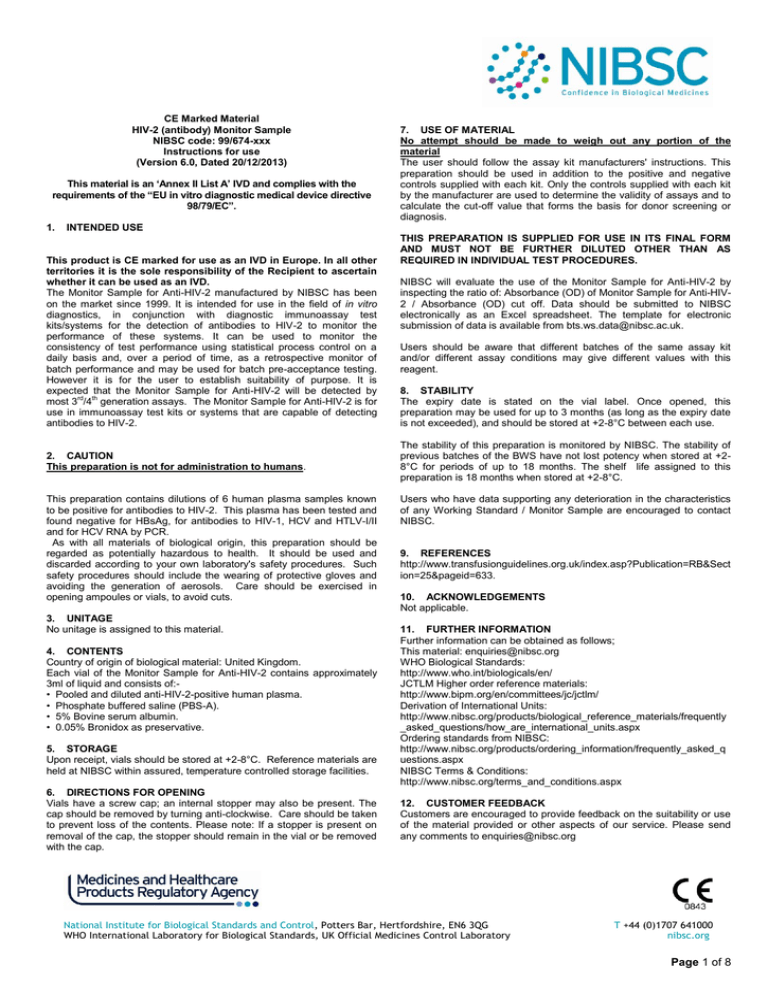
CE Marked Material HIV-2 (antibody) Monitor Sample NIBSC code: 99/674-xxx Instructions for use (Version 6.0, Dated 20/12/2013) This material is an „Annex II List A‟ IVD and complies with the requirements of the “EU in vitro diagnostic medical device directive 98/79/EC”. 1. 7. USE OF MATERIAL No attempt should be made to weigh out any portion of the material The user should follow the assay kit manufacturers' instructions. This preparation should be used in addition to the positive and negative controls supplied with each kit. Only the controls supplied with each kit by the manufacturer are used to determine the validity of assays and to calculate the cut-off value that forms the basis for donor screening or diagnosis. INTENDED USE This product is CE marked for use as an IVD in Europe. In all other territories it is the sole responsibility of the Recipient to ascertain whether it can be used as an IVD. The Monitor Sample for Anti-HIV-2 manufactured by NIBSC has been on the market since 1999. It is intended for use in the field of in vitro diagnostics, in conjunction with diagnostic immunoassay test kits/systems for the detection of antibodies to HIV-2 to monitor the performance of these systems. It can be used to monitor the consistency of test performance using statistical process control on a daily basis and, over a period of time, as a retrospective monitor of batch performance and may be used for batch pre-acceptance testing. However it is for the user to establish suitability of purpose. It is expected that the Monitor Sample for Anti-HIV-2 will be detected by most 3rd/4th generation assays. The Monitor Sample for Anti-HIV-2 is for use in immunoassay test kits or systems that are capable of detecting antibodies to HIV-2. 2. CAUTION This preparation is not for administration to humans. This preparation contains dilutions of 6 human plasma samples known to be positive for antibodies to HIV-2. This plasma has been tested and found negative for HBsAg, for antibodies to HIV-1, HCV and HTLV-I/II and for HCV RNA by PCR. As with all materials of biological origin, this preparation should be regarded as potentially hazardous to health. It should be used and discarded according to your own laboratory's safety procedures. Such safety procedures should include the wearing of protective gloves and avoiding the generation of aerosols. Care should be exercised in opening ampoules or vials, to avoid cuts. 3. UNITAGE No unitage is assigned to this material. 4. CONTENTS Country of origin of biological material: United Kingdom. Each vial of the Monitor Sample for Anti-HIV-2 contains approximately 3ml of liquid and consists of:• Pooled and diluted anti-HIV-2-positive human plasma. • Phosphate buffered saline (PBS-A). • 5% Bovine serum albumin. • 0.05% Bronidox as preservative. 5. STORAGE Upon receipt, vials should be stored at +2-8°C. Reference materials are held at NIBSC within assured, temperature controlled storage facilities. 6. DIRECTIONS FOR OPENING Vials have a screw cap; an internal stopper may also be present. The cap should be removed by turning anti-clockwise. Care should be taken to prevent loss of the contents. Please note: If a stopper is present on removal of the cap, the stopper should remain in the vial or be removed with the cap. THIS PREPARATION IS SUPPLIED FOR USE IN ITS FINAL FORM AND MUST NOT BE FURTHER DILUTED OTHER THAN AS REQUIRED IN INDIVIDUAL TEST PROCEDURES. NIBSC will evaluate the use of the Monitor Sample for Anti-HIV-2 by inspecting the ratio of: Absorbance (OD) of Monitor Sample for Anti-HIV2 / Absorbance (OD) cut off. Data should be submitted to NIBSC electronically as an Excel spreadsheet. The template for electronic submission of data is available from [email protected]. Users should be aware that different batches of the same assay kit and/or different assay conditions may give different values with this reagent. 8. STABILITY The expiry date is stated on the vial label. Once opened, this preparation may be used for up to 3 months (as long as the expiry date is not exceeded), and should be stored at +2-8°C between each use. The stability of this preparation is monitored by NIBSC. The stability of previous batches of the BWS have not lost potency when stored at +28°C for periods of up to 18 months. The shelf life assigned to this preparation is 18 months when stored at +2-8°C. Users who have data supporting any deterioration in the characteristics of any Working Standard / Monitor Sample are encouraged to contact NIBSC. 9. REFERENCES http://www.transfusionguidelines.org.uk/index.asp?Publication=RB&Sect ion=25&pageid=633. 10. ACKNOWLEDGEMENTS Not applicable. 11. FURTHER INFORMATION Further information can be obtained as follows; This material: [email protected] WHO Biological Standards: http://www.who.int/biologicals/en/ JCTLM Higher order reference materials: http://www.bipm.org/en/committees/jc/jctlm/ Derivation of International Units: http://www.nibsc.org/products/biological_reference_materials/frequently _asked_questions/how_are_international_units.aspx Ordering standards from NIBSC: http://www.nibsc.org/products/ordering_information/frequently_asked_q uestions.aspx NIBSC Terms & Conditions: http://www.nibsc.org/terms_and_conditions.aspx 12. CUSTOMER FEEDBACK Customers are encouraged to provide feedback on the suitability or use of the material provided or other aspects of our service. Please send any comments to [email protected] National Institute for Biological Standards and Control, Potters Bar, Hertfordshire, EN6 3QG WHO International Laboratory for Biological Standards, UK Official Medicines Control Laboratory T +44 (0)1707 641000 nibsc.org Page 1 of 8 13. CITATION In all publications, including data sheets, in which this material is referenced, it is important that the preparation's title, its status, the NIBSC code number, and the name and address of NIBSC are cited and cited correctly. 14. MATERIAL SAFETY SHEET Physical and Chemical properties Physical Corrosive: No appearance: Liquid Stable: Oxidising: No Yes Hygroscopic: Irritant: Yes (contains Bronidox) No Flammable: Handling: See caution, Section 2 No Other (specify): Contains material of human origin. Toxicological properties Effects of inhalation: Not established. Avoid inhalation. May contain infectious HIV. Effects of ingestion: Not established. Avoid ingestion. May contain infectious HIV. Effects of skin absorption: Not established. Avoid contact with skin. May contain infectious HIV. Suggested First Aid Inhalation: Seek medical advice. Ingestion: Seek medical advice. Contact with eyes: Wash with copious amounts of water. Seek medical advice. Contact with skin: Wash thoroughly with water. Action on Spillage and Method of Disposal Spillage of vial contents should be taken up with absorbent material wetted with an appropriate disinfectant. Rinse area with an appropriate disinfectant followed by water. Absorbent materials used to treat spillage should be treated as biological waste. 15. LIABILITY AND LOSS In the event that this document is translated into another language, the English language version shall prevail in the event of any inconsistencies between the documents. Unless expressly stated otherwise by NIBSC, NIBSC’s Standard Terms and Conditions for the Supply of Materials (available at www.nibsc.org/About_Us/Terms_and_Conditions.aspx or upon request by the Recipient) (“Conditions”) apply to the exclusion of all other terms and are hereby incorporated into this document by reference. The Recipient's attention is drawn in particular to the provisions of clause 11 of the Conditions. 16. INFORMATION FOR CUSTOMS USE ONLY Country of origin for customs purposes*: United Kingdom * Defined as the country where the goods have been produced and/or sufficiently processed to be classed as originating from the country of supply, for example a change of state such as freeze-drying. Net weight: 3g per vial. Toxicity Statement: Non-toxic. Veterinary certificate or other statement if applicable. Attached: No National Institute for Biological Standards and Control, Potters Bar, Hertfordshire, EN6 3QG WHO International Laboratory for Biological Standards, UK Official Medicines Control Laboratory T +44 (0)1707 641000 nibsc.org Page 2 of 8 Arbeitsstandard HIV-2 (Antikörper), Überwachungsprobe NIBSC-Code: 99/674 Gebrauchsanweisung (Version 6.00) Dieses Material ist ein IVD nach „Anhang II, Liste A“ und entspricht den Anforderungen der Richtlinie 98/79/EG der EU über In-vitro-Diagnostika. 1. VERWENDUNGSZWECK Dieses Produkt ist CE markiert für die Verwendung als IVD in Europa. In allen anderen Gebieten ist es die alleinige Verantwortung des Empfängers festzustellen ob das Produkt als IVD verwendet werden kann. Die vom NIBSC hergestellte Überwachungsprobe für Anti-HIV-2 ist seit 1999 auf dem Markt erhältlich. Sie ist zu Verwendung im Bereich der Invitro-Diagnostik zusammen mit diagnostischen Immunassay-Kits bzw. Systemen zum Nachweis von HIV-2-Antikörpern zur Überwachung der Wirksamkeit dieser Systeme bestimmt. Es kann täglich zur Überwachung der Konsistenz der Testergebisse mit Hilfe statistischer Prozesskontrolle und über einen bestimmten Zeitraum als rückblickende Überwachung der Wirksamkeit der Charge und zum Testen von Chargen vor der Abnahme eingesetzt werden. Es obliegt jedoch dem Benutzer, die Eignung für einen bestimmten Zweck festzustellen. Es wird erwartet, dass die Überwachungsprobe für Anti-HIV-2 von den meisten Assays der 3. bzw. 4. Generation nachgewiesen wird. Die Uberwachungsprobe für Anti-HIV-2 ist für Gebrauch innen immunassay Kits bzw. Systemen das sind zum Entdecken fähig HIV-2-Antikörpern. 2. VORSICHT Dieses Präparat ist nicht zur Verabreichung an Menschen bestimmt. Dieses Präparat enthält Verdünnungen von 6 menschlichen Plasmaproben, die bekanntermaßen positiv für HIV-2-Antikörper getestet haben. Dieses Plasma ist mit Polymerasekettenreaktion auf HBsAg, HIV-1, HCV und HTLV-I/II-Antikörper sowie HCV-RNS getestet und negativ befunden worden. Wie alle Materialien biologischen Ursprungs muss dieses Präparat als potenziell gesundheitsgefährdend betrachtet werden. Es sollte gemäß den Sicherheitsverfahren Ihres Labors verwendet und entsorgt werden. Derartige Sicherheitsverfahren umfassen vermutlich das Tragen von Schutzhandschuhen und das Vermeiden der Entstehung von Aerosolen. Beim Öffnen von Ampullen oder Fläschchen muss vorsichtig vorgegangen werden, um Schnittverletzungen zu vermeiden. 3. EINHEITENZUWEISUNG Diesem Material sind keine Einheiten zugewiesen. 4. INHALT Ursprungsland des biologischen Materials: Vereinigtes Königreich. Jedes Fläschchen der Überwachungsprobe für Anti-HIV-2 enthält ungefähr 3 ml Flüssigkeit und besteht aus: • Gepooltem und verdünntem Anti-HIV-2-positivem menschlichen Plasma. • Phosphatgepufferter Kochsalzlösung (PBS-A) . • 5% Rinderserumalbumin. • 0,05% Bronidox als Konservierungsstoff. 5. LAGERUNG Die Fläschchen sollten nach Erhalt bei +2°-8°C gelagert werden. Referenzmaterialien werden beim NIBSC in gesicherten, temperaturgeregelten Lagerräumen aufbewahrt. 6. ANWEISUNG ZUM ÖFFNEN Die Fläschchen haben einen Deckel mit Schraubverschluss. Außerdem kann ein Innenstopfen vorhanden sein. Der Schraubdeckel sollte durch Drehen gegen den Uhrzeigersinn abgenommen werden. Es muss darauf geachtet werden, dass der Inhalt nicht verschüttet wird. Bitte beachten: Ist bei Abnehmen des Schraubdeckels ein Stopfen vorhanden, muss der Stopfen entweder im Fläschchen verbleiben oder mit dem Deckel entfernt werden. 7. VERWENDUNG DES MATERIALS Es darf nicht versucht werden, einen Teil des Materials abzuwiegen. Der Benutzer muss die Anweisungen des Assay-Kit-Herstellers befolgen. Dieses Präparat muss zusätzlich zu den positiven und negativen Kontrollen verwendet werden, die mit jedem Kit geliefert werden. Nur die mit jedem Kit vom Hersteller gelieferten Kontrollen werden zur Feststellung der Gültigkeit von Assays und zur Berechnung des Grenzwerts benutzt, der die Basis für Spender-Screening oder Diagnose darstellt. DIESES PRÄPARAT IST ZUR VERWENDUNG IN SEINER ENDGÜLTIGEN FORM BESTIMMT UND DARF NICHT WEITER ALS FÜR INDIVIDUELLE TESTVERFAHREN ERFORDERLICH VERDÜNNT WERDEN. Das NIBSC bewertet die Verwendung der Überwachungsprobe für AntiHIV-2 durch Prüfung des folgenden Verhältnisses: Absorptionsvermögen (optische Dichte) der Überwachungsprobe für Anti-HIV-2 / Grenzwert für das Absorptionsvermögen (optische Dichte). Die Daten müssen bei NIBSC in elektronischer Form als Excel-Tabelle eingereicht werden. Die Vorlage für die elektronische Dateneinreichung ist bei [email protected] erhältlich. Benutzer müssen sich bewusst sein, dass Chargen des gleichen AssayKits und/oder unterschiedlicher Assay-Bedingungen mit diesem Reagens unterschiedliche Werte ergeben können. 8. STABILITÄT Das Verfalldatum ist auf dem Fläschchenetikett angegeben. Nach dem Öffnen kann dieses Präparat bis zu 3 Monate lang benutzt werden (solange das Verfalldatum nicht überschritten wird) und muss zwischen jeder Verwendung bei +2-8°C aufbewahrt werden. Die Stabilität dieses Präparats wird vom NIBSC überwacht. Die Stabilität früherer Chargen des britischen Arbeitsstandards haben bei Lagerung bei +2-8°C über Zeiträume von bis zu 18 Monaten nicht an Wirksamkeit verloren. Die diesem Präparat zugewiesene Haltbarkeit bei Lagerung bei +2-8°C beträgt 18 Monate. Benutzer, die Daten vorzuweisen haben, die auf eine Verschlechterung der Eigenschaften eines Arbeitsstandards/einer Überwachungsprobe deuten, werden aufgefordert, sich an das NIBSC zu wenden. 9. LITERATUR http://www.transfusionguidelines.org.uk/index.asp?Publication=RB&Sec tion=25&pageid=633. 10. DANKSAGUNGEN Keine. 11. WEITERE INFORMATIONEN Weitere Informationen sind erhältlich bei: Zu diesem Material: [email protected] Biologische WHO-Standards: http://www.who.int/biologicals/en/ JCTLM höherer Ordnungbezugsmaterialien: http://www.bipm.org/en/committees/jc/jctlm/ Herleitung internationaler Einheiten: http://www.nibsc.ac.uk/products/ordering_information/frequently_asked_ questions.aspx Bestellung von Standards beim NIBSC: http://www.nibsc.ac.uk/products/ordering_information/frequently_asked_ questions.aspx Geschäftsbedingungen des NIBSC: http://www.nibsc.ac.uk/terms_and_conditions.aspx National Institute for Biological Standards and Control, Potters Bar, Hertfordshire, EN6 3QG WHO International Laboratory for Biological Standards, UK Official Medicines Control Laboratory T +44 (0)1707 641000 nibsc.org Page 3 of 8 12. KUNDENRÜCKMELDUNGEN Die Kunden werden ermutigt, Rückmeldungen über die Eignung oder Verwendung des gelieferten Materials oder andere Aspekte unserer Dienstleistungen einzusenden. Bitte schicken Sie alle Kommentare an [email protected]. 13. ZITIERUNG IN DER LITERATUR Bei allen Veröffentlichungen, einschließlich Datenblättern, in denen auf dieses Material verwiesen wird, ist es wichtig, dass die Bezeichnung, der Status und die NIBSC-Codenummer des Präparats sowie Name und Anschrift des NIBSC zitiert, und zwar korrekt zitiert werden. Ursprungsland für Zollzwecke*: Vereinigtes Königreich * Als das Land definiert, in dem die Waren produziert und/oder ausreichend verarbeitet worden sind, um als aus dem Lieferland stammend klassifiziert zu werden, zum Beispiel durch eine Zustandsänderung wie Gefriertrocknen. Nettogewicht: 3 g pro Fläschchen. Toxizitätserklärung: Nicht toxisch. Tiermedizinische Bescheinigung oder andere Erklärung ggfs. beigefügt: Nein Beigefügt: Nein 14. MATERIALSICHERHEITSDATENBLATT Physikalische und chemische Eigenschaften Zustand: Flüssig Stabil: Ja Korrodierend: Nein Oxidierend: Nein Hygroskopisch: Reizend: Ja (enthält Bronidox) Nein Entflammbar: Handhabung: Siehe Vorsichtshinweis, Abschnitt Nein 2 Sonstige (bitte angeben): Enthält Material menschlichen Ursprungs. Toxikologische Eigenschaften Wirkung bei Einatmen: Nicht untersucht. Einatmen vermeiden. Kann infektiöses HIV enthalten. Wirkung bei Verschlucken: Nicht untersucht. Verschlucken vermeiden. Kann infektiöses HIV enthalten. Wirkung bei Absorption durch die Haut: Nicht untersucht. Hautkontakt vermeiden. Kann infektiöses HIV enthalten. Empfohlene Erste Hilfe-Maßnahmen: Einatmen: Ärztliche Hilfe suchen. Verschlucken: Ärztliche Hilfe suchen. Augenkontakt: Mit reichlich Wasser spülen. Ärztliche Hilfe suchen. Hautkontakt. Gründlich mit Wasser abwaschen. Maßnahmen bei Verschütten und Entsorgungsmethoden Verschütteter Fläschcheninhalt muss mit absorbierendem Material aufgenommen werden, das mit einem geeigneten Desinfektionsmittel benetzt worden ist. Spülen Sie den Bereich mit einem geeigneten Desinfektionsmittel und anschließend mit Wasser. Absorbierendes Material, das zum Aufnehmen von verschüttetem Inhalt verwendet worden ist, muss als biologischer Abfall entsorgt werden. 15. HAFTUNGSAUSSCHLUSS Für den Fall, dass dieses Dokument in eine andere Sprache übersetzt wird, gilt die englische Version falls Unstimmigkeiten zwischen den Dokumenten auftreten. Sofern nicht ausdrücklich anders von NIBSC angegeben, gelten die NIBSC allgemeinen Geschäftsbedingungen für die Lieferung von Materialien www.nibsc.org/About_Us/Terms_and_Conditions.aspx oder auf Anforderung des Empfängers) ("Bedingungen") zum Ausschluss aller anderen Bestimmungen und werden hiermit unter Bezug in dieses Dokument eingearbeitet. Die Aufmerksamkeit des Empfängers wird insbesondere auf die Bestimmungen der Klausel 11 der Bedingungen gezogen. 16. INFORMATIONEN FÜR DEN ZOLL National Institute for Biological Standards and Control, Potters Bar, Hertfordshire, EN6 3QG WHO International Laboratory for Biological Standards, UK Official Medicines Control Laboratory T +44 (0)1707 641000 nibsc.org Page 4 of 8 Standard de travail Échantillon de référence pour l'anti-VIH-2 (anticorps) Code NIBSC : 99/674 Mode d‟emploi (Version 6.00) Ce matériel est un IVD de type « Annexe II Liste A» et il est conforme aux exigences de la « Directive 98/79/EC de l'UE relative aux dispositifs médicaux de diagnostic in vitro. » 1. UTILISATION PRÉVUE Ce produit est marqué CE pour utilisation comme IVD en Europe. Dans tous les autres territoires, il est de la seule responsabilité du destinataire de déterminer si il peut être utilisé comme un IVD. L’échantillon de référence pour l'anticorps anti-VIH-2 fabriqué par le NIBSC est sur le marché depuis 1999. Il est destiné à être utilisé dans le domaine des diagnostics in vitro, conjointement avec des systèmes/trousses de diagnostic par immunodosage pour la détection d'anticorps anti-VIH-2 afin de contrôler la performance de ces systèmes. Il peut être utilisé pour surveiller la cohérence des performances des tests en utilisant un contrôle statistique des processus de manière quotidienne et, sur une période de temps, afin de procéder à un contrôle rétrospectif des performances des lots ainsi que comme contrôle avant d'accepter les lots. Toutefois, il incombe à l’utilisateur d’établir la pertinence de cet objectif. Il est prévu que l'échantillon de référence pour l'anticorps anti-VIH-2 soit détecté dans la plupart des dosages de 3ème et 4ème génération. L’échantillon de référence pour l'anticorps anti-VIH-2 est utilisé à avec d'essai kits ou systèmes qui sont capables de détecter d'anticorps à VIH-2. 2. MISE EN GARDE Cette préparation ne doit pas être administrée à des êtres humains. Cette préparation contient une dilution d'un pool de plasmas préparé à partir de 6 échantillons de plasma humain connus pour être positifs visà-vis des anti-VIH-2. Ce plasma a été testé et trouvé négatif vis-à-vis des l'AgHBs, des anti-VHC, anti-VIH-1 et anti-HTLV-I/II, et à l'ARN du VHC par PCR. Comme toutes les matières d'origine biologique, cette préparation doit être considérée comme dangereuse pour la santé. Elle doit être utilisée et éliminée conformément aux procédures de sécurité de votre laboratoire. Ces procédures comportent probablement le port de gants de protection et des mesures permettant d'éviter la formation d'aérosols. Il convient de prendre des précautions lors de l'ouverture des ampoules ou des flacons pour éviter les coupures. 3. UNITÉS Aucune unité n'a été attribuée à ce matériel. 4. CONTENU Pays d’origine du matériel biologique : Royaume-Uni. Chaque flacon d’échantillon de référence pour l'anti-VIH-2 renferme environ 3 ml de liquide, contenant : des plasmas positifs vis-à-vis des anti-VIH-2 dilués et regroupés en pool Solution saline tamponnée de phosphate (PBS-A). 5 % d’albumine sérique bovine (BSA). 0,05 % de Bronidox comme conservateur. 5. CONSERVATION Les flacons doivent être conservés à 2-8 °C dès réception. Les matériels de référence sont conservés au NIBSC dans des installations de stockage assurées à température contrôlée. 6. CONSIGNES D‟OUVERTURE Les flacons sont dotés d'un bouchon à vis et éventuellement d'un bouchon étanche interne. Retirez le bouchon en le faisant tourner dans le sens inverse des aiguilles d'une montre. Veillez à ne pas renverser le contenu. Veuillez noter : si un bouchon interne est présent, il doit rester dans le flacon ou être retiré avec le bouchon à vis. 7. EMPLOI DU MATÉRIEL Ne pas tenter de peser une partie du matériel quelle qu'elle soit. L'utilisateur doit suivre les instructions fournies par le fabricant de la trousse de dosage. Cette préparation doit être utilisée en plus des contrôles positifs et négatifs fournis avec chaque lot de trousses. Seuls les contrôles fournis avec chaque trousse par le fabricant sont utilisés pour déterminer la validité des dosages et calculer la valeur limite qui constitue la base de dépistage des donneurs ou de diagnostic. CETTE PRÉPARATION EST FOURNIE PRÊTE À L'EMPLOI SOUS SA FORME FINALE ET NE DOIT ÊTRE DILUÉE D'AUCUNE AUTRE FAÇON QUE CELLES QUE NÉCESSITENT LES PROCÉDURES DE TEST INDIVIDUELLES. Le NISBC évaluera l’utilisation de l’échantillon de référence pour les anti-VIH-2 en examinant le rapport entre : Absorbance (DO) de l’échantillon de test/Absorbance (DO) limite. Les données doivent être transmises au NIBSC par voie électronique sous forme de feuille de calcul EXCEL. Le modèle devant être utilisé pour une transmission électronique des données est disponible à l'adresse suivante : [email protected]. Les utilisateurs doivent être informés que des lots différents provenant de la même trousse de dosage et/ou différentes conditions de dosage peuvent donner des valeurs différentes avec ce réactif. 8. STABILITÉ La date de péremption figure sur l’étiquette du flacon. Une fois ouverte, cette préparation peut être utilisée pendant 3 mois. Elle doit être conservée à 2-8 °C entre chaque utilisation. La stabilité de ce matériel est contrôlée par le NIBSC. La stabilité des lots précédents de standard de travail britannique n’a pas diminué au cours d'une période de conservation de 18 mois à 2-8 °C. La durée de conservation attribuée au standard de travail sera de 18 mois quand il est conservé à 2-8 °C. Les utilisateurs disposant de données indiquant une détérioration des caractéristiques d'un standard de travail sont priés de contacter le NIBSC. 9. RÉFÉRENCES http://www.transfusionguidelines.org.uk/index.asp?Publication=RB&Sect ion=25&pageid=633. 10. REMERCIEMENTS Sans objet 11. AUTRES INFORMATIONS D’autres informations sont disponibles comme suit : sur le matériel : [email protected] Normes biologiques de l’OMS : http://www.who.int/biologicals/en/ Documentations de référence évoluées de JCTLM: http://www.bipm.org/en/committees/jc/jctlm/ Dérivation des Unités Internationales : http://www.nibsc.ac.uk/products/ordering_information/frequently_asked_ questions.aspx Commande de standard auprès du NIBSC : http://www.nibsc.ac.uk/products/ordering_information/frequently_asked_ questions.aspxTermes et conditions du NIBSC : http://www.nibsc.ac.uk/terms_and_conditions.aspx 12. COMMENTAIRES DES CLIENTS National Institute for Biological Standards and Control, Potters Bar, Hertfordshire, EN6 3QG WHO International Laboratory for Biological Standards, UK Official Medicines Control Laboratory T +44 (0)1707 641000 nibsc.org Page 5 of 8 Les clients sont invités à fournir leurs commentaires sur la pertinence ou l’utilisation du matériel fourni ou d’autres aspects de notre service. Veuillez adresser vos commentaires à [email protected]. 13. CITATION Dans toutes les publications, y compris les fiches de données , dans lesquelles la préparation est utilisée comme matériel de contrôle de dosage, il est important que le titre de la préparation, son statut, le code NIBSC et le nom et l’adresse du NIBSC soient cités correctement. 14. FICHE DE SÉCURITÉ DU MATÉRIEL 16. INFORMATIONS RÉSERVÉES À L‟USAGE DES DOUANES Pays d‟origine pour les douanes* : Royaume-Uni * Défini comme étant le pays où les produits ont été fabriqués et/ou suffisamment traités pour être classés comme provenant du pays de fourniture, par exemple un changement d'état tel qu'une lyophilisation. Poids net : 3 g par flacon Déclaration de toxicité : Non toxique Certificat vétérinaire ou autre déclaration le cas échéant Pièce jointe : Non Propriétés physiques et chimiques Aspect physique : Liquide Corrosif : Non Stable : Oui Oxydant : Non Hygroscopique : Non Irritant : Oui (contient du Bronidox) Inflammable : Non Manipulation : Voir précautions, Section 2 Autre (préciser) : Contient des matières d’origine humaine Propriétés toxicologiques Effets de l’inhalation : Non établis. Éviter l’inhalation. Susceptible de contenir des VIH infectieux. Effets de l’ingestion : Non établis. Éviter l’ingestion. Susceptible de contenir des VIH infectieux. Effets de l’absorption cutanée : Non établis. Éviter le contact avec la peau. Susceptible de contenir des VIH infectieux. Suggestions de mesures de première urgence Inhalation : Consulter un médecin Ingestion : Consulter un médecin Contact avec les yeux : Laver à grande eau. Consulter un médecin Contact avec la peau : Laver minutieusement avec de l’eau. Mesure en cas d'écoulement accidentel et méthode d'élimination Les écoulements accidentels provenant des flacons doit être traités avec un tampon absorbant imbibé d'un désinfectant approprié. Laver la zone avec un désinfectant approprié, puis avec de l’eau. Les tampons absorbants utilisés pour traiter les écoulements accidentels doivent être considérés comme des déchets présentant des dangers biologiques. 15. RESPONSABILITÉ ET PERTE Dans le cas où ce document est traduit dans une autre langue, la version anglaise prévaudra en cas de contradiction entre les documents. Sauf indication contraire par l’Institut NIBSC, les Termes et Conditions standard de NIBSC pour la fourniture de matériaux (disponible à www.nibsc.org/About_Us/Terms_and_Conditions.aspx ou à la demande du destinataire) ("Conditions") s'appliquent à l'exclusion de toutes autres conditions et sont incorporés dans le présent document par référence. L'attention du destinataire est attirée en particulier sur les dispositions de l'article 11 des Conditions. National Institute for Biological Standards and Control, Potters Bar, Hertfordshire, EN6 3QG WHO International Laboratory for Biological Standards, UK Official Medicines Control Laboratory T +44 (0)1707 641000 nibsc.org Page 6 of 8 Material con marcado CE VIH-2 (anticuerpo), Muestra de control Código NIBSC: 99/674-xxx Indicaciones de uso (Versión 6.00) Este material es un dispositivo para diagnóstico in vitro de la “Lista A del Anexo II” y cumple con los requisitos de la Directiva 98/79/CE de la UE sobre productos sanitarios para diagnóstico in vitro. 1. USO INDICADO Este producto lleva la marca CE para su uso como IVD en Europa. En todos los demás territorios, es la responsabilidad exclusiva del Destinatario el determinar si se puede utilizar como un IVD. La muestra de control para el anti-VIH-2 fabricado por NIBSC ha estado en el mercado desde 1999. Está indicada para usarse en el campo de diagnósticos in vitro, junto con los equipos o sistemas de ensayo de inmunoanálisis de diagnóstico para la detección de anticuerpos frente al VIH-2, con el objetivo de controlar el desempeño de estos sistemas. Puede usarse para controlar la constancia del desempeño de los ensayos, utilizando un control estadístico de procesos de forma diaria y, durante un período de tiempo determinado, como un control retrospectivo de la efectividad del lote. También puede usarse para pruebas antes de la aceptación de lotes. Sin embargo, corresponde al usuario determinar la adecuación para el fin buscado. Se espera que la muestra de control para el anti-VIH-2 sea detectada en la mayoría de los análisis de 3ra o 4ta generación. La muestra de control para el antiVIH-2 debe usarse en equipos o sistemas de ensayo de inmunoanálisis capaces de detectar los anticuerpos frente al VIH-2. 2. ADVERTENCIA Este preparado no debe administrarse a seres humanos. Este preparado contiene diluciones de 6 muestras de plasma humano positivas a los anticuerpos del VIH-2. Este plasma ha sido ensayado, dando negativo a HBsAg, a anticuerpos de VIH-1, VHC y VLTH-I/II, y al ARN de VHC por medio de RCP. Al igual que para cualquier material de origen biológico, este preparado debe considerarse potencialmente nocivo para la salud. Se debe utilizar y desechar conforme a los procedimientos de seguridad vigentes en su laboratorio. Dichos procedimientos de seguridad deberán incluir el uso de guantes de protección así como evitar la generación de aerosoles. Cuide de no sufrir cortes al abrir ampollas o viales. 3. INFORMACIÓN CUANTITATIVA No hay información cuantitativa para este material. 4. CONTENIDO País de origen del material biológico: Reino Unido. Cada vial de la muestra de control para el anti-VIH-2 contiene aproximadamente 3 ml de líquido y está compuesto por: • • • • Plasma humano combinado y diluido, positivo al anti-VIH-2. Solución salina tamponada con fosfato (PBS-A). Seroalbúmina bovina al 5%. Bronidox al 0,05% como conservante. 5. ALMACENAMIENTO A su recepción, los viales se deben almacenar a +2-8 °C. Los materiales de referencia se conservan en el NIBSC en instalaciones de almacenamiento seguras a temperatura controlada. 6. INSTRUCCIONES PARA LA APERTURA Los viales cuentan con una tapa roscada; es posible que lleven también un tapón interior. Se debe quitar la tapa girándola en sentido antihorario. Tenga cuidado de no perder el contenido. Nota: Si al quitar la tapa se halla un tapón, el mismo debe quedar en el vial o ser quitado junto con la tapa. 7. USO DEL MATERIAL No se debe intentar separar ninguna porción del material según su peso El usuario debe seguir las instrucciones del fabricante que aparecen en el equipo de ensayo. Este preparado debe utilizarse adicionalmente a los controles positivo y negativo que se suministran con cada equipo. Solamente los controles suministrados por el fabricante con cada equipo se utilizan para determinar la validez de los ensayos y para calcular el valor límite que constituye la base del análisis o diagnóstico del donante. ESTE PREPARADO DEBE SER UTILIZADO TAL COMO SE SUMINISTRA Y NO DEBE DILUIRSE DE OTRA MANERA DIFERENTE A LA QUE SE INDICA EN LOS REQUISITOS DE LOS PROCEDIMIENTOS DE ANÁLISIS INDIVIDUALES. NIBSC evaluará el uso de la muestra de control para los anticuerpos frente al VIH-2 inspeccionando la proporción de: absorbancia (densidad óptica) de la muestra de control para el anti-VIH-2 / límite de absorbancia (densidad óptica). Debe enviarse la información a NIBSC de forma electrónica como una hoja de cálculo de Excel. La plantilla para enviar la información electrónicamente se puede solicitar a [email protected]. Los usuarios deben tener en cuenta que lotes distintos del mismo equipo de ensayo y/o diferentes condiciones de ensayo pueden conducir a valores diferentes con este reactivo. 8. ESTABILIDAD La fecha de caducidad está indicada en la etiqueta del vial. Una vez abierto, este preparado puede usarse por 3 meses máximo (siempre y cuando no se haya excedido la fecha de caducidad) y debe conservarse a una temperatura de +2-8 °C entre un uso y otro. NIBSC monitoriza la estabilidad de este preparado. La estabilidad de los lotes anteriores del patrón de trabajo británico no ha perdido potencia al conservarse a +2-8 °C por períodos de hasta 18 meses. La vida útil asignada a este preparado es de 18 meses cuando se conserva a +2-8 °C. Se insta a los usuarios que tengan datos que señalan un deterioro cualquiera de las características de algún patrón de trabajo o muestra de control, a ponerse en contacto con NIBSC. 9. REFERENCIAS http://www.transfusionguidelines.org.uk/index.asp?Publication=RB&Sect ion=25&pageid=633. 10. RECONOCIMIENTOS No aplicable. 11. INFORMACIÓN ADICIONAL Se puede obtener más información según se detalla a continuación.Este material: [email protected] Normas y patrones biológicos de la OMS: http://www.who.int/biologicals/en/ Materiales de referencia de orden superior del JCTLM: http://www.bipm.org/en/committees/jc/jctlm/ Obtención de las unidades internacionales: http://www.who.int/biologicals/reference_preparations/en/ Encargar patrones de NIBSC: http://www.nibsc.ac.uk/products/ordering_information/frequently_asked_ questions.aspx Términos y condiciones del NIBSC: National Institute for Biological Standards and Control, Potters Bar, Hertfordshire, EN6 3QG WHO International Laboratory for Biological Standards, UK Official Medicines Control Laboratory T +44 (0)1707 641000 nibsc.org Page 7 of 8 http://www.nibsc.ac.uk/terms_and_conditions.aspx 12. COMENTARIOS DE CLIENTES Instamos a nuestros clientes a enviarnos sus comentarios sobre la adecuación o el uso de los materiales que suministramos, o sobre otros aspectos de nuestro servicio. Sírvase enviar sus comentarios a [email protected]. provenientes del país de suministro, por ejemplo, un cambio de estado tal como la liofilización. Peso neto: 3 g por vial. Declaración de toxicidad: no tóxico. Certificado veterinario u otra declaración si corresponde. Adjunto: No 13. ATRIBUCIONES En todas las publicaciones, incluidas las hojas de datos, en las cuales se haga referencia a este material, es importante que se atribuyan - y en forma correcta - el título del preparado, su estado, el número de código del NIBSC, y el nombre y dirección del NIBSC. 14. HOJA DE DATOS SOBRE SEGURIDAD DEL MATERIAL Propiedades físicas y químicas Aspecto físico: Corrosivo: No Líquido Estable: Oxidante: No Sí Higroscópico: Irritante: Sí (contiene Bronidox) No Inflamable: Manipulación: Véase la advertencia en No la Sección 2. Otros (especificar): Contiene material de origen humano. Propiedades toxicológicas Efectos de la inhalación: No establecido. Evitar la inhalación. Puede contener VIH contagioso. Efectos de la ingestión: No establecido. Evitar la ingestión. Puede contener VIH contagioso. Efectos de la absorción por la piel: No establecido. Evitar el contacto con la piel. Puede contener VIH contagioso. Medidas de primeros auxilios sugeridas Inhalación: Acuda al médico. Ingestión: Acuda al médico. Contacto con los ojos: Lavar con agua en abundancia. Acuda al médico. Contacto con la piel: Lavar meticulosamente con agua. Medidas ante un derrame y método de desecho Si se derrama el contenido de un vial, deberá recogerse con un material absorbente mojado con un desinfectante adecuado. Lave la zona con un desinfectante adecuado y luego con agua. Los materiales absorbentes usados para resolver el derrame deberán tratarse como un desecho biológico. 15. RESPONSABILIDAD Y PÉRDIDAS En el caso de que este documento sea traducido a otro idioma, la versión en inglés prevalecerá en el caso de cualquier inconsistencia entre los documentos. A menos que se indique expresamente lo contrario por NIBSC, los Términos y Condiciones Estándar de NIBSC para el Suministro de Materiales (disponible en www.nibsc.org/About_Us/Terms_and_Conditions.aspx o previa solicitud por parte del Receptor) ("Condiciones") se aplican a la exclusión de todos los demás términos y estan incorporados en este documento como referencia. El Destinatario debe prestar atención, en particular, a las disposiciones de la cláusula 11 de las Condiciones. 16. INFORMACIÓN PARA USO EXCLUSIVO DE LA ADUANA País de origen a efectos de aduanas*: Reino Unido * Se define como el país en el cual la mercadería se fabricó y/o procesó en una medida suficiente como para ser clasificada como National Institute for Biological Standards and Control, Potters Bar, Hertfordshire, EN6 3QG WHO International Laboratory for Biological Standards, UK Official Medicines Control Laboratory T +44 (0)1707 641000 nibsc.org Page 8 of 8
